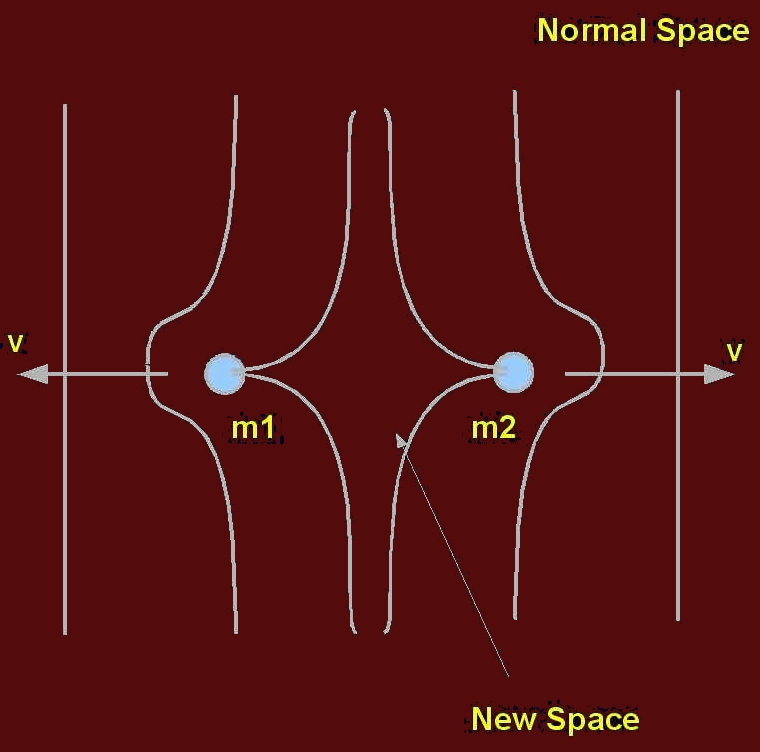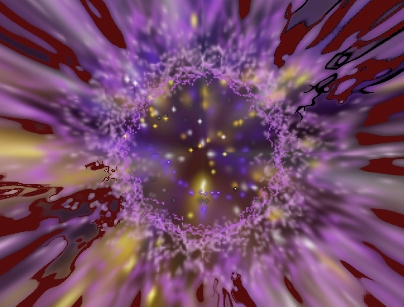Why 'Expansion' is Wrong
As Einstein proposed in his general theory of relativity, space can be considered as having a geometric construction where the presence of matter causes an indent in that geometric form, thus creating the phenomena that we have named gravitational pull.
I intend to take another view of this understanding and show that matter, instead of changing an existing space, actually creates space by virtue of its relative motion with other matter.
For example, consider two masses m1 and m2 (see diagram below) nearby to each other. We know that there must be a gravitational pull between them and everything else in the universe. This is also defined by Einstein's geometric 'dips' at each object's location. The spatial effect (i.e. gravity) will cause them to move towards each other and collide or possibly orbit each other until a stable condition exists. If both objects were already moving apart, there would still be an attraction but if the velocity was sufficiently fast they would escape from each other. As they move apart the gravitational pull decreases with distance (squared, as in Newton's theory).
As the objects move apart, consider this: Are they moving through space or are they creating the space between them? Space is simply the geometric interaction between m1 and m2 and of course other masses.

Creation of Space
The creation of space is like pulling apart a thick sheet of rubbery foam, except that the elastic tension decreases with distance.
The
'New' Space will eventually blend into 'Normal' space but only when New
Space reaches a critical state of tension, i.e. when external
gravitational forces from Normal Space equals the 'stretched' tension.
This critical tension will depend upon the mass and velocity of the
parting objects.
Note: I think that this critical tension will also limit the distance that gravitational waves can travel.
The universe that we see is thought to be 'expanding' and that objects further away are apparently travelling away from us at a faster speed than nearer objects (hence red shift phenomena). One of the big questions is whether the expansion of the universe is constant, speeding up or slowing down?
For masses to escape their gravitational pulls their velocities must be sufficiently fast enough to overcome the gravitational pull. If not, then they will either collide or start orbiting each other in a stable state. Beyond the critical tension, the masses will become more influenced by the matter in the surrounding universe (i.e. Normal Space) and the attraction between the masses will be lost to the universal attractions. Therefore, for the universe to be in a stable state, it must either be revolving, creating a centrifugal force counteracting the gravitational pull of all the matter in the universe, or being pulled by an external force or other effect.
Consider this: If
the universe is revolving, then we need to consider the effect of time
to create a 4-dimensional model. The rotation of the universe just
after the big bang would theoretically have been faster than now
because the universe was smaller (according to established theories).
In
fact, as demonstrated by the two masses in the previous diagram, a relative
'universal escape velocity' between all
masses in the universe would be required to create a stable,
constantly expanding, universe. If space is being created by this
method of expansion, then it would be logical to assume that the outer
limits would need to rotate fast enough to counteract the gravitational
pull of the mass of universe (no matter exists outside to attract
either)! This would be an impossible situation in a spherical shape
that we seem to observe. It
is unlikely that an external force would exist outside our universe,
unless it belonged to a another universe or negative (dark?) matter
within our own universe.
There must be another explanation. I will explain in the following paragraphs.
Inspanding Universe

The only logical conclusion is that the universe cannot be expanding but 'INspanding', with the dimensions of time and space being created within the singularity from the point of birth.
If
time began after the birth of our universe, then according to most theories the
initial inpansion happened very fast and has slowed down as time
progressed.
As shown in Einstein's relativity theories, travelling at
the speed of light dilates time and space to zero, in fact the
conditions of a singularity. If all objects are inspanding at the speed
of light, this suggests that the singularity and our
'normal' dimensions can coexist and relative speeds of neighbouring
objects traveling at less than the speed of light can also exist.
As space is created, the universe appears to be expanding from our viewpoint from within our universe. Our current position in time will always be equidistant from the birth. Time and space are being created slower and slower, hence further points in space seem to be expanding away from us, with the slowest expansion locally and the fastest expansion furthest away; an observation made only over recent years. An inspanding universe explains this observation and removes the need to create ideas of external attraction forces and to explain the distant acceleration effect.
Because of the coexistence of the singularity and our dimensions, the inspansion rate will slow down over time, but if we are travelling relatively away from the birth at the speed of light, then time and space are relatively zero and are consistent with the singularity.
Is Space Infinite or Finite
As an example, if there was a single star with a planet orbiting it, would this be the limit of the universe and does space exist beyond this point. How do you detect space, since it does not exist? It is a well justified theory that space and time did not exist before the big merge, therefore where we see the furthest extent of our universe, it is in the past at the time when the big merge occurred and it would be reasonable to assume that space may not exist beyond that place.
In fact, if the volume of space is finite, then the boundary limit will occur at zero hour (the beginning of our universe) but eventually it will need to have an end. The speed of light (c) is proved to be constant and relativity shows its connection with the movement through time, as shown by his separation equation below:
s2=t2- (r/c)2
Where:s=separation time (Y)
t=observed time (Y)
r=radius (distance travelled in LY)
c=velocity of light (i.e. 1 LY per Y)
By observing the doppler ‘red-shift’ of elements of the electromagnetic spectrum, we can make estimates of the distance of stars and galaxies in deep space. This is based on the reasonable assumption that light travels at constant speed and that the greater the distance of an object, the faster the object is moving away from us (as determined by Hubble’s constant relating to the expansion of the universe, starting from the Big Merge). However, when we measure the red-shift of a star, we are looking at the star in the past, which means that a correction is required for the time difference?
As suggested before there may be no single age of the universe? One conclusion could be that the universe exists across time, not at a point in time.
As the separation theory shows, if we travel (velocity v) at the speed of light (v/c=1), it would take us zero time and we would move no distance, due to dilation. But you may rightly ask what the meaning of speed is at the SOL. If we travel less than the SOL, we experience different time dilations, see diagram below. The faster we travel (speed s) between points A and B, the nearer we aproach the centre at v/c=1. The observer experiences time t when watching us travel between A and B, this is because the relative speed of the observer is less.

Fig 6.2 Dilation Diagram
As the diagram shows, although we experience time passing ourselves, the relative nature of time and space create a universe that exists across time and yet entertain zero time and space at v/c=1, as represented in the diagram above. I think that the Dilation Diagram represents the 4-dimensional model of the universe and dilation could be considered as a fifth dimension.
It is important not to treat this model as a shape for our universe. The universe has no observable or calculatable 'shape' because an instant snapshot is not possible. It cannot be observed because light, and all EM waves, are from the past and cannot exist without time; it cannot be calculated at a single point in time, because our universe exists across time and we have no awareness of the complete universe. The reason I mentioned this is because scientists seem to be discussing various shapes for our universe, yet are not allowing for universal time and dilation effects!
The circumference of
the circle in the diagram represents the life (i.e. time of existence)
of the universe from the Big Merge to it's end (if any). The spokes are
shown here as linear, but are in fact spiral in shape because of the
square law (artistic license due to my drawing limitations!). The
centre could be considered as a singularity where space and time are
non-existent. By travelling at the SOL we become a singularity at the
centre, but by lowering our speed again we can appear at any point or
time in our universe; this means that we can't travel faster than
light, but we can jump through the singularity to anywhere else at
another time (control of entry and exit would be the main problem?).
This concept of space
travel also fits with the Inspansion theory because inpansion is
occuring at the speed of light within the singularity so any object
travelling at the speed of light will also become the singularity.